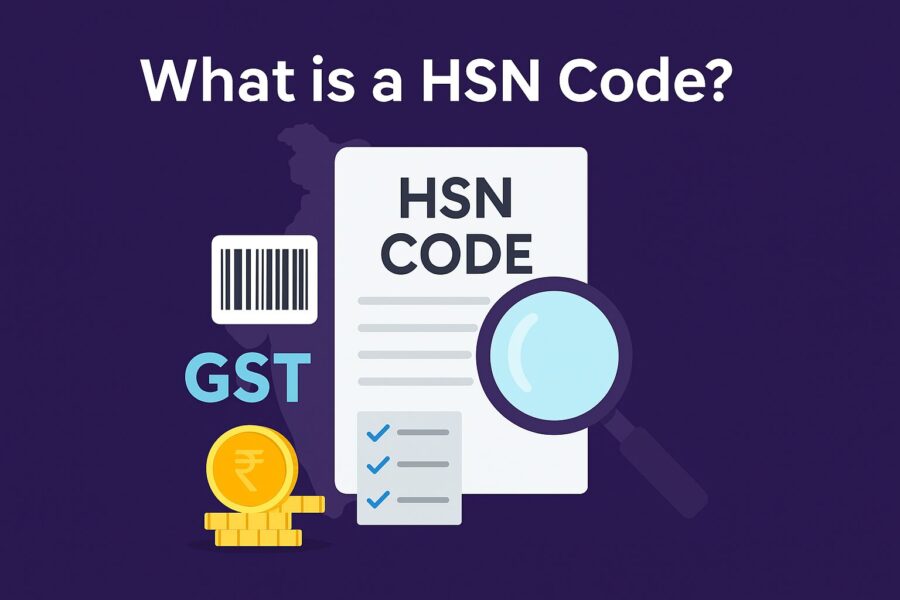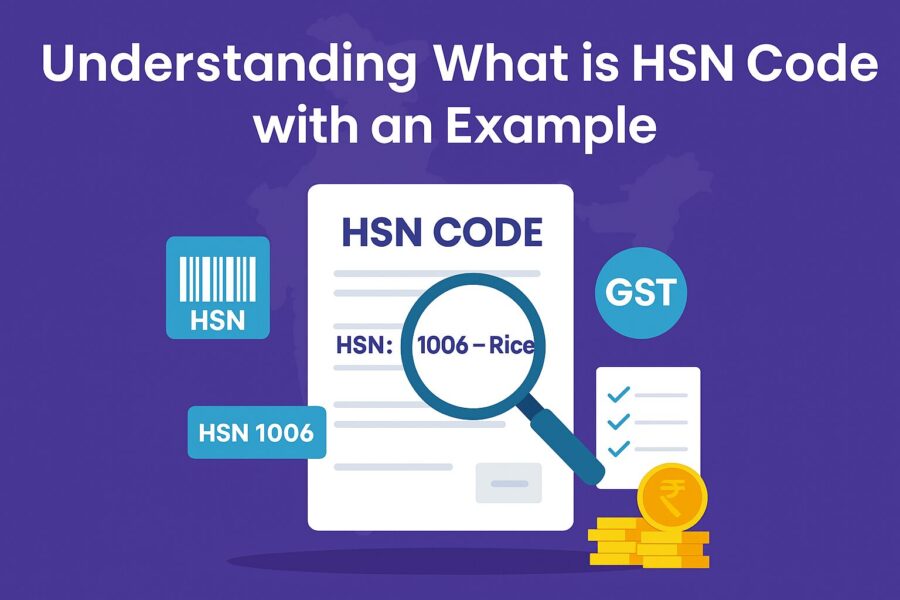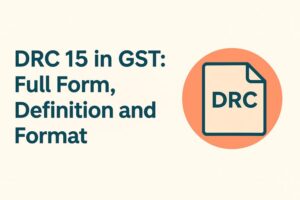How to Find HSN Code in GST Portal | Complete Guide
- 29 Sep 25
- 8 mins

How to Find HSN Code in GST Portal | Complete Guide
Key Takeaways
- HSN code in GST is a globally recognised classification system that ensures uniform taxation and simplifies trade compliance.
- Businesses with turnover above ₹5 crores must mention 4-digit HSN codes, while importers/exporters must use 8-digit HSN codes for accuracy.
- You can easily find HSN code on the GST portal by logging in, going to Services > User Services > Search HSN Code, and entering product details.
- Using the correct HSN code in GST invoices helps avoid tax penalties, ensures accurate GST filing, and speeds up return processing.
- Regularly check the HSN code list for GST or consult experts to stay updated and ensure proper classification for both domestic and international trade.
The introduction of the Goods and Services Tax (GST) regime has brought in a demand for standard classification of goods in India. The essential element of this process is the Harmonised System of Nomenclature (HSN) code which ensures that there is consistency in the identification of the products, primarily during their taxation in a given country.
This blog discusses the meaning of HSN codes and their structure, applicability as well as how to find HSN code on the GST portal.
What is a HSN Code?

The HSN code or the Harmonised System of Nomenclature which is an internationally recognised regulatory framework for ranking goods under systematic categorisation, was created by the World Customs Organisation (WCO). The main purpose of this system is to make a consistent classification of products, make trade easy and also maintain the proper taxation.
The HSN code all over the world is in 6 digits but in India, it has been extended to 8-digit code to make it more specific. It is applied by a large number of countries (> 200 countries) in customs and trade applications, and it has 5,000+ commodity groups that appear with unique code names.
HSN Code in India
India took up the HSN code system in 1986 in its customs and central excise duties and introduced its use further on with the GST regime. The Indian HSN standardised code is based on an 8-digit arrangement, permitting other finer categorisation of goods.
The organisation of a precise code is shown below:
- First 2 figures: This is referred to as the chapter number (specifies the general category of goods).
- Next 2 characters: It is the heading (refers to a particular product group in the chapter).
- Following 2 figures: Also called the subheading (provides additional classification).
- Last 2 characters: This is the tariff item (offers detailed product identification specific to India).
The classification of goods under this hierarchical system is clear and standardised and there are fewer chances that a businessman or tax authority will not be in a position to know the exact rate of GST to be met and paid.
Understanding What is HSN Code with an Example

To genuinely understand how the HSN code operates, let us dive into a practical example:
Example 1: Leather Handbag
- Chapter: The first two digits indicate the chapter. Leather products are categorised under Chapter 42, which encompasses “Articles of leather; saddlery and harness as well as travel goods, handbags, and similar containers”.
- Heading: The next two digits pinpoint the heading within that chapter. For leather handbags, the heading is 42.02, covering “trunks, suitcases, vanity cases, executive cases, briefcases, school satchels, spectacle cases, binocular cases, camera cases, musical instrument cases, gun cases, holsters, and similar containers”.
- Subheading: The following two digits provide a more specific classification of the product. For handbags, the subheading is 21, which refers to “Handbags, whether or not with shoulder strap, including those without a handle, with an outer surface of leather”.
So, the complete correct code for a leather handbag is 4202.21.
Now, let us look at another example.
Example 2: Cotton T-Shirts
This product will fall under Chapter 61 which contains articles of apparel and clothing accessories, both knitted or crocheted. Next, the heading component will be 09 - specific for t-shirts, singlets, and other vests.
After this, you can notice the subheading as 10 which signifies that the product is made of cotton. Finally, the code entry for tariff item will be 00 (specific to India).
Therefore, the code structure for cotton t-shirts is 61091000.
Applicability of HSN Code
In India, HSN code applicability is subject to turnover limits and type of the transaction. Here's how it works:
- Business Turnover of Less than ₹1.5 Crore: There is no compulsory need to mention the HSN code in the invoices as well as the GST returns.
- Companies with Turnovers Ranging Between ₹1.5 Crore and ₹5 Crore: It is compulsory to enter the appropriate 2-digit HSN code.
- Entities With Turnover Exceeding ₹5 Crore: These companies or individuals must compulsorily mention 4-digit HSN codes.
- Importers and Exporters: They will have to use the entire 8-digit HSN code on all commodities, with a view to being on par with international standards.
This step-structured system enables small companies to prevent a useless burden of compliance but large companies and organisations engaged in cross-border trading will have to give detailed product classification for accurate tax compliance.
How to Find HSN Code?

To become GST compliant, it is important to know the right HSN code to use for your product. These are the key methods of finding the appropriate HSN code:
Method 1: Via GST Portal
For those who might be wondering how to find HSN code on the GST portal, they must know that the official GST website offers a feature that allows users to directly search for HSN codes.
To accomplish the task, =follow these instructions:
Step 1: Log into your GST account.
Step 2: Go to ‘Services’ followed by ‘User Services’ and click on ‘Search HSN Code’. The user can initiate a search by entering at least the first 3 characters of the chapter code. Otherwise, you may also search by entering product descriptions.
Method 2: Through HSN Code Lists
Various government and individual websites have published full-blown HSN lists. These lists present all the appropriate chapters, then headings and so on, which enables easier browsing and finding the applicable code of your goods.
Method 3: By Consulting Experts
In case it is a complex product or involves doubt, it will be ideal to consult a GST expert to address tax implications. Inappropriate classification can lead to fines or wrong tax deposits.
Tips for Accurate HSN Code Selection
To avoid HSN-related errors in tax filing, follow the tactics given below:
- Always refer to the latest HSN code directory, as codes and descriptions may be updated periodically.
- Ensure that the code matches the specific characteristics of your product, including material, function and intended use.
- For exporters and importers, always use the full 8-digit code to comply with international trade requirements.
Conclusion
The HSN code system is a cornerstone of India’s GST framework, enabling standardised classification and taxation of goods. By understanding the structure and applicability of HSN codes, business owners can ensure compliance, avoid disputes and streamline their tax processes.
Whether you are a small trader or a large manufacturer, knowing how to find HSN code on the GST portal is essential for smooth operations and regulatory adherence in the Indian market. Make sure you identify the right code for your products and stay updated with any changes to the classification system.
💡If you want to streamline your payment and make GST payments via credit, debit card or UPI, consider using the PICE App. Explore the PICE App today and take your business to new heights.
FAQs
What is an HSN code in GST?
Who needs to use HSN codes in India?
How do I find HSN code on the GST portal?
Visit the official GST portal and log in.
Go to Services > User Services > Search HSN Code.
Enter at least 3 digits of the HSN or product description.
The system displays the correct HSN code with tax rates.
This ensures accurate HSN code in GST invoices and filing.

















